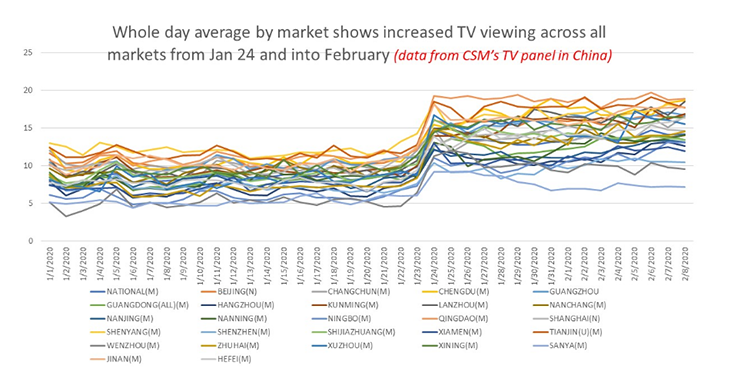Picture this – you’re home 24/7 for a couple of months, working remotely.
What’s likely to happen? You’ll have more time on your hands, unless you’re one of those rare people who put in more hours working from home than you do in the office.
What do you do with all that extra time? Not surprisingly, data from the habits of consumers in China over the last few weeks of being confined at home with the coronavirus scare show increases in media consumption of every sort – from playing games to watching movies and shows at home. I’ve added here a chart that shows a clear jump in TV viewing during this period.

Now, think about that from the perspective of a typical consumer-facing brand – be it soap, soft drinks, packaged food, snacks or even bigger ticket items like household appliances, home workout equipment and so forth. All these are things you’re more likely to buy and use during a prolonged period of staying at home, especially if you can’t have your ‘ayi’ [Editor’s note: 阿姨 in Chinese, meaning ‘aunt’ as well as a polite way to address a lady hired to clean a home, a common practice for middle-class consumers] come by to do the chores.
For brands like these, this is a golden opportunity to talk to consumers with all the increased media consumption behaviour they’re exhibiting and help them do things in the time that lies idle on their hands.
Yet, at the same time that people are at home and presenting brands with such a marvellous opportunity, factories are shut or operating at less than full capacity, logistics are disrupted, and both offline and online retail are diminished.
In theory, this should be a boom for e-commerce but with uncertainty in door-to-door deliveries, people are less likely to order anything perishable or time-sensitive since they then have to go to their building or compound entrances to collect their orders, using up the scarce and invaluable resource of a surgical mask to shield themselves from infection while doing so.
Restaurants that rely on food delivery services are on the verge of going bust, partly because outlets are forced to be closed, partly because there are restrictions on delivering directly to doorsteps, and partly because of trust issues with food that came from outside the home.
So, what can brands do in this period when they can’t drive transactions through advertising?
Here’s a thought, use this time to build a relationship with your consumers. You know, that old-fashioned brand-building thing we used to talk about 20 years ago? Consumers are home, bored, looking for distractions and productive things to do with their time as well as seeking real information on the coronavirus, how to prevent it, how it’s spreading, and so on and so forth. What better time for advertisers to step up to the plate and win consumers over to their brands?
Here’re a few ideas I can think of:
1. A quick-service restaurant could run an online contest on the best home recipes using fried chicken (or any food type) with consumers voting for their favourites. The winning recipe could be selected as an actual menu item for when the coronavirus confinements end. This idea could apply to any food brand – not necessarily a restaurant, even an instant noodles brand or brands in similar categories.
2. As the weather warms up, Coca Cola could run ads on the “perfect serve” at home – something which is a big part of the Coke brand in markets outside China and normally gets too little attention. Here is the perfect chance to show people how to enjoy Coke optimally, when they have the luxury of time to make ice and prepare their drink in a manner that provides the best brand experience.
3. Home-appliance brands – especially robotic vacuum cleaners, automated washing machines, hi-tech cooking tools that normally don’t get used daily – is one category likely to be in demand now, especially for homebound consumers not used to doing chores by themselves. These brands have a content opportunity to run short videos on getting the most out of the gadgets. Presumably, current owners will use them more and non-owners will be tempted to buy them.
Just yesterday, I noticed a local flower-delivery platform, FlowerPlus, that adapted to the constraints of coronavirus-posed challenges. Since they didn’t have the staff to manually combine different flower types into the mixes and bouquets that consumers usually order (also, some consumers are currently reluctant to let something that had been touched by other hands into their premises), the brand opened up their platform to flower-growers. Any individual flower-grower (not necessarily a FlowerPlus supplier) can register themselves to fulfil any orders that still came in via FlowerPlus. Chinese courier company SF Express helped by setting up a ‘no-hands’ (contactless) delivery system. FlowerPlus is now charging a fraction of its usual prices, since they can only handle single-flower arrangements, instead of mixed bouquets, for the time being.
All in all, the boutique brand has been fast to adjust to changes, and this move will keep the business alive with new suppliers for itself and will aid the entire flower-farming ecosystem during this tough time. As of the first six days of this activity, according to the company’s own data, nearly 2.09 million stalks were replenished from over 37 flower-growers who would otherwise have their flower inventory wilt and die.
My point is, we normally complain about the fact that we’re living in a low-attention economy where it’s really hard to get people to pay heed to advertisements.
This is the one period of time when there is a real possibility to turn that around. It looks as if things are starting to return to normal as six provinces in China have reduced their emergency alert levels, so the window of opportunity may not be open for much longer.
This article was featured in WARC.
First featured 26/02/2020.

